I was recently invited to create and deliver a series of 3 workshops for the Healthcare Businesswomen Association (HBA). Having served the HBA as an active member for over 10 years, I could not have been happier to accept the invitation. My ambition was to create a transformative workshop series with practical, science-backed tools to help participants lead with confidence, build impactful relationships, and create habits for long-lasting success.
In the first workshop – Communicate Your Value with Confidence – I set the stage drawing from neuroscience and cognitive psychology and how we can harness these insights for increased confidence talking to ourselves and communicating our value to others.
Understanding our Brain’s Quirks
Our brain is an extraordinary “connection machine,” housing close to 90 billion neurons, with the majority capable of 20 to 30 connections with other neurons. This innate drive means our brain is constantly forming new wiring throughout our life, making every brain unique, shaped by individual experiences.
To keep this amazing performance going, our brain is a high-energy consumer and constantly strives to save energy. It does this by hardwiring information and habits, making automatic perception a key function. While efficient, this makes deconstructing old wiring or habits difficult, especially if ingrained over time.
A key challenge is our brain’s tendency to keep things in conscious awareness that haven’t been figured out or don’t make sense. This means problems or struggles are more likely to occupy our thoughts than our successes, which are often taken for granted and become our “new normal,” impacting confidence.
Shifting Focus: The “Gap and the Gain” Model
To counteract the brain’s natural inclination to focus on what’s missing, the “Gap and the Gain” model, developed by Dan Sullivan and Ben Hardy, encourages individuals to measure progress by looking back at achievements rather than focusing on the distance to an ideal goal, thereby boosting confidence. In other words:
- Avoid the “Gap”: Many high achievers measure their current progress against an ambitious, ideal future goal. This creates a “gap” between achievements and visionary targets, leading to feelings of disappointment, frustration, or failure, which diminishes confidence.
- Embrace the “Gain”: A more effective strategy is to measure backwards. Instead of comparing yourself to an ideal, look back at what you have already achieved since you started. Appreciating your accomplishments fosters satisfaction and success, significantly boosting self-esteem and confidence. This model highlights that prior success, not confidence itself, is what truly creates confidence.
Storytelling our Achievements: Applying STAR
Leveraging my experience as recruiter and Executive Search leader, I introduce the STAR model (Situation, Task, Action, Result) as a storytelling framework to communicate achievements with confidence. If you have prepared for job interviews either as a candidate or hiring manager you will be very familliar with the STAR model. Here’s what it stands for:
- S – Situation: Describe the context or circumstances.
- T – Task: Outline your mission or what you aimed to achieve.
- A – Action: Detail the specific steps you personally took.
- R – Result: Explain the positive outcome or impact of your actions.
Using the STAR model to create achievement stories increases our confidence by focusing on our strengths and what we did well. It is not only highly effective for CVs and interviews, achievement stories help us be remembered by others because stories are more memorable than mere facts.
Practical Steps to Boost Your Confidence
The workshop concludes inviting participants to take practical steps turning insights into action. For instance, by measuring 3 wins every day before going to sleep. Or by wrapping their achievements into the STAR model (Situation, Task, Action, Result) to create achievement stories.
Excerpt Unlocking Success through Neuroscie
Stefanie`s training methodology is results-oriented, focusing on practical strategies that drive tangible outcomes. Her approach not only equipped participants with the tool they need to succeed but also inspire action. In closing, she reinforced the importance of taking immediate steps to apply the insights shared, motivating everyone to turn knowledge into action.
– Vittoria Chiesa, PhD – HBA Program Leader


